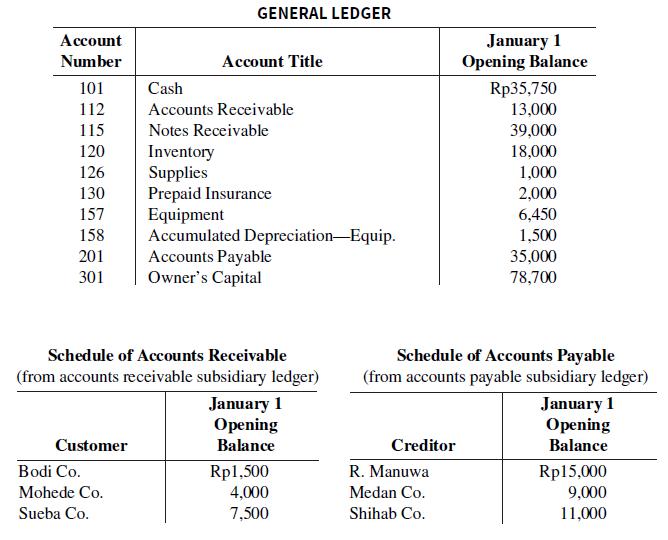Koto Merchants uses a perpetual inventory system and both an accounts receivable and an accounts payable subsidiary
Question:
Koto Merchants uses a perpetual inventory system and both an accounts receivable and an accounts payable subsidiary ledger. Balances related to both the general ledger and the subsidiary ledgers for Koto are indicated (amounts in thousands). Also following are a series of transactions for Koto for the month of January. Credit sales terms are 2/10, n/30. The cost of all merchandise sold was 60% of the sales price.

Jan. 3 Sell merchandise on account to B. Chen Rp3,600, invoice no. 510, and to Tjong Company Rp1,800, invoice no. 511.
5 Purchase merchandise from Goh Co. Rp5,000 and D. Phe Rp2,200, terms n/30.
7 Receive checks from Mohede Rp4,000 and Sueba Rp2,000 after discount period has lapsed.
8 Pay freight on merchandise purchased Rp235.
9 Send checks to Medan for Rp9,000 less 2% cash discount, and to Shihab for Rp11,000 less 1% cash discount.
9 Issue credit of Rp300 to Tjong for merchandise returned.
10 Daily cash sales from January 1 to January 10 total Rp15,500. Make one journal entry for these sales.
11 Sell merchandise on account to Bodi Rp1,600, invoice no. 512, and to Mohede Rp900, invoice no. 513.
12 Pay rent of Rp1,000 for January.
13 Receive payment in full from B. Chen and Tjong less cash discounts.
15 The owner withdrew Rp800 cash.
15 Post all entries to the subsidiary ledgers.
16 Purchase merchandise from Shihab Rp15,000, terms 1/10, n/30; Medan Rp14,200, terms 2/10, n/30; and Goh Rp1,500, terms n/30.
17 Pay Rp400 cash for office supplies.
18 Return Rp200 of merchandise to Medan and receive credit.
20 Daily cash sales from January 11 to January 20 total Rp20,100. Make one journal entry for these sales.
21 Issue Rp15,000 note, maturing in 90 days, to R. Manuwa in payment of balance due.
21 Receive payment in full from Mohede less cash discount.
Jan. 22 Sell merchandise on account to B. Chen Rp2,700, invoice no. 514, and to Bodi
Rp2,300, invoice no. 515.
22 Post all entries to the subsidiary ledgers.
23 Send checks to Shihab and Medan for full payment less cash discounts.
25 Sell merchandise on account to Sueba Rp3,500, invoice no. 516, and to Tjong Rp6,100, invoice no. 517.
27 Purchase merchandise from Shihab Rp14,500, terms 1/10, n/30; D. Phe Rp3,200, terms n/30; and Goh Rp5,400, terms n/30.
27 Post all entries to the subsidiary ledgers.
28 Pay Rp200 cash for office supplies.
31 Daily cash sales from January 21 to January 31 total Rp21,300. Make one journal entry for these sales.
31 Pay sales salaries Rp4,300 and office salaries Rp3,800.
Instructions
a. Record the January transactions in a sales journal, a single-column purchases journal, a cash receipts journal as shown in Illustration 7.9, a cash payments journal as shown in Illustration 7.16, and
a two-column general journal.
b. Post the journals to the general ledger.
c. Prepare a trial balance at January 31, 2020, in the trial balance columns of the worksheet. Complete the worksheet using the following additional information.
1. Office supplies at January 31 total Rp900.
2. Insurance coverage expires on October 31, 2020.
3. Annual depreciation on the equipment is Rp1,500.
4. Interest of Rp50 has accrued on the note payable.
d. Prepare an income statement and an owner’s equity statement for January and a classified statement of financial position at the end of January.
e. Prepare and post adjusting and closing entries.
f. Prepare a post-closing trial balance, and determine whether the subsidiary ledgers agree with the control accounts in the general ledger.
Step by Step Answer:

Accounting Principles
ISBN: 978-1119419617
IFRS global edition
Authors: Paul D Kimmel, Donald E Kieso Jerry J Weygandt





